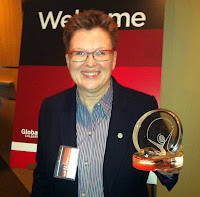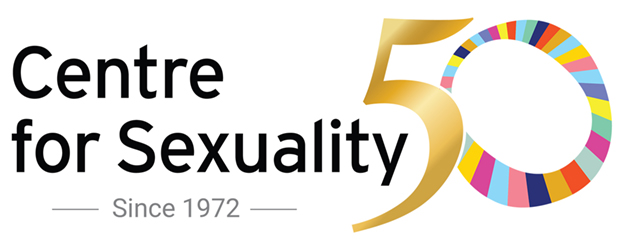Prior to our AGM in June, we sat down with Pam Krause, Executive Director of Calgary Sexual Health Centre to reflect on 2012 and the year ahead.
2012 was an exciting year, especially because CSHC celebrated its 40th anniversary. What were the highlights for you?
We did an event every month in 2012, so we made sure there were lots of community connections to help celebrate our 40th year. Our anniversary gala was a huge part of the year for me because we had alumni from the earliest days of the organization there. It brought home to me why we began, and it also helped me recognize what a substantial part of the community this organization has been for 40 years.
 |
| Pam was recognized by Global Calgary in 2012 as a “Woman of Vision”. |
What really struck me that evening was how many things have changed and at the same time how little things have changed. Looking back, we had this immense core of support that led us to do courageous stuff that nobody else would do, and I look to today, and that is exactly the role that we still play. We have a core group of people who support us and have allowed us to be really courageous with our actions, and now it manifests in programs like FAIR and the Training Centre and WiseGuyz.
What was new for CSHC in 2012?
One of the most exciting things for me was seeing FAIR (Families Achieving Inclusive Relationships) get off the ground. It was the culmination of a lot of work engaging immigrant and newcomer communities and building relationships with youth, parents, and organizations.
We also started to see a greater focus on prevention. That includes the great success of our Training Centre, the move to serve more youth in junior high schools – and potentially elementary schools – and finding new ways to engage parents through that work. I think those are all massively important in our organization’s overall goal of normalizing sexuality.
What were the biggest challenges for the organization in 2012?
We continue to struggle with funding because we’re very committed to the populations we serve and we’re often ahead of the curve in our work. Sometimes that means that funding structures aren’t necessarily caught up with us.
FAIR is a really good example of this. Because it’s true community development, we couldn’t wait for the funding piece to come forward. We needed it to be really organic and to actually see where it went first. The challenge was staying true to our client base and staying true to our innovative programming and then also having enough resources to do all the work we wanted to do. We really depend on individual donors to help us continue to do that cutting-edge work.
What are you most looking forward to in 2013?
I’m looking forward to being an organization that is even more heavily focused on community impact.We’re looking at our work with a critical lens to ensure it’s accomplishing the goals we want to achieve. Also the work we’re doing with WiseGuyz, tying research to curriculum and building it in to a best practice, is a very exciting model that we’ll roll out in 2013, and we’ll then start to look at replicating it.
Moving in to the new world of developmental evaluation and validated outcomes doesn’t sound exciting but it is. It helps us tell the story of the impact we have and see the bigger picture. It’s a transformation from being really grassroots to being more disciplined and intentional about the impact we want to have, and knowing if we get there.
What are the opportunities for Calgary Sexual Health Centre going forward?
There are way more opportunities for us to work in other parts of the province, to focus not just on the city but on the rural areas where the need is great. There are also huge opportunities in continuing to have really comprehensive programming. We now have a well-established Training Centre, so we have an opportunity to reach clients, and then reach the professionals to sustain our work and build organizational capacity.
The words that we used 40 years ago are very similar to the words we use today – it was all about constantly pushing the boundaries. We’ve always done the critical work no one else wants to take on. That’s the essence of who we are, that deep connection to the community and the people we serve which leads us to do exceptionally innovative programming.

